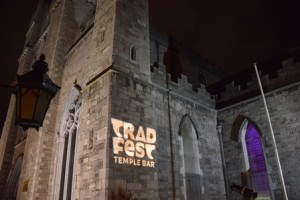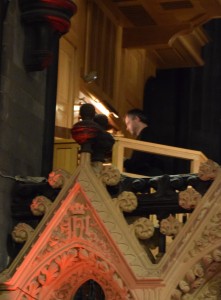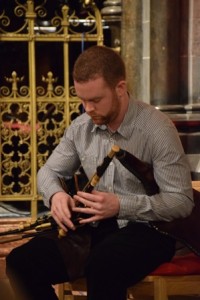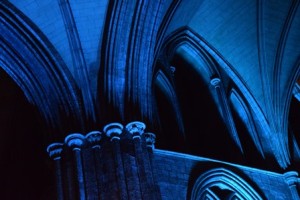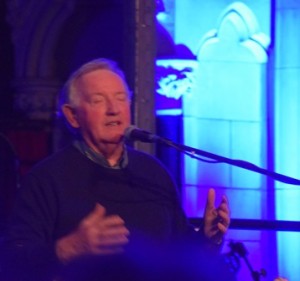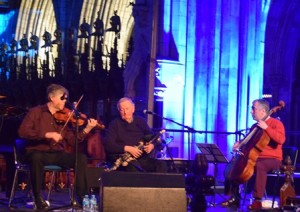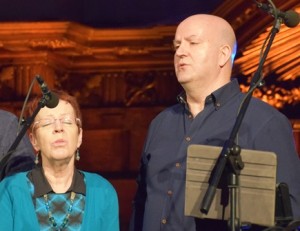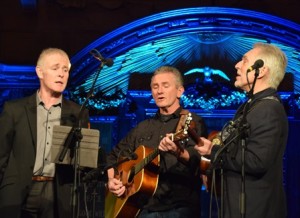35 Legend That She Is
Posted by Christine on Feb 16, 2015 in Ireland | 0 comments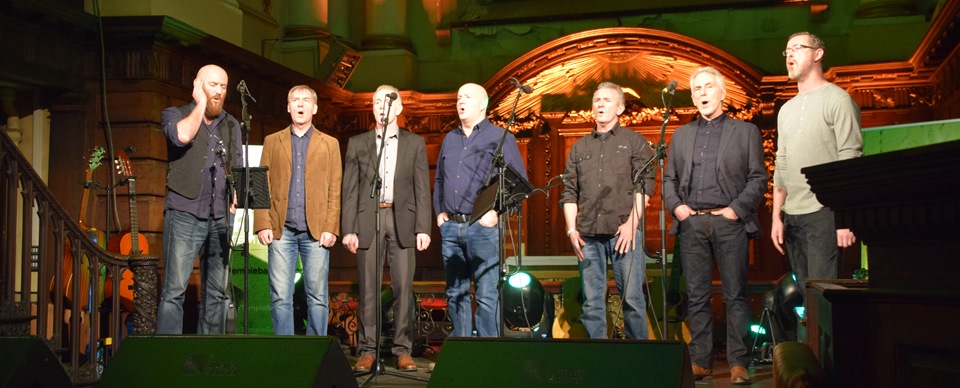
TradFest 2015 (January 28 to February 1) here in Dublin was filled with live music, music from the present of the Irish traditional or folk scene as well as from its past, and by design and by luck, music from my past. At the three concerts Ron and I attended, I got to hear from some of the musicians who hooked me on this genre back in the days of vinyl records, when I had only been to Ireland once and didn’t know anything about the sources of the music, the instruments played, or the musicians and groups leading the movement.
TradFest is a ten-year-old festival of Irish traditional music. For a few nights in the cold of winter, groups, soloists, and amazing combinations of musicians play in venues around Temple Bar, the trendy nightlife area of Dublin along the south bank of the River Liffey between the medieval city and O’Connell Bridge.
With its windy cobblestone streets and alleys with names like “Fishamble Street,” “Cow’s Lane,” and “Copper Alley,” Temple Bar recalls old Dublin. By the 1980s the area had become home to shops, artists, galleries, bars, and restaurants, and was saved from the bulldozer when protests and legal action eventually prevented the state-owned transportation company from building a bus terminal there. Today with several theatres, the Irish Film Institute, and many music venues, Temple Bar is considered a cultural center of the city, though the abundance of pubs makes it a noisy nightlife scene as well. The Temple Bar Company, a business association that focuses on preserving this historic part of Dublin, started TradFest in 2006 with the goal of creating “a festival showcasing the cream of both Irish and international trad and folk artists while also providing a stage to promote the next generation of Irish musicianship.”
As it turned out, all three of the concerts I chose were held in churches: the city’s two historic cathedrals, Christ Church and St. Patrick’s, and the less well-known and faded but still beautiful St. Werburgh’s. The atmosphere of these buildings and the acoustics of their large stone caverns make them wonderful places to hear music. And because it was a festival and not a formal concert, there was an exciting looseness and an intimacy to the programs. No one minded you taking pictures, and there was a lot of only slightly covert recording going on.
I couldn’t resist the intriguing concept of Friday afternoon’s concert at Christ Church, which introduced an unusual yet strangely apropos combination of sounds to the “trad” world: the pipe organ and the uilleann pipes. The uilleann (ILL-en) pipes are the more melodious, more indoors friendly cousin to the Scottish pipes, and are named after the Gaelic word for “elbow” because the musician’s elbow movements work the bellows that provide air for the pipes. This instrument makes the distinctive sound that characterizes much of Irish folk music and is more associated with a cottage fireside or a barn dance than with the church. David Bremner, assistant organist at the cathedral and uilleann piper Mark Redmond first played together a few years ago by chance and found the musical relationship of their two usually solo instruments exciting enough to pursue. Their collaboration led to a CD that was launched at the cathedral last fall.
Bremner sat in the organ loft above the choir while Redmond played from his chair on the floor of the nave, but in spite of the distance between them, their music was totally in sync. Combining the classical organ repertoire (especially Couperin) with that of folk music, they played solo pieces and duets, exploring harmonies and dissonances, and handing the lead back and forth to each other with great skill and musicality. Hearing these two instruments work together illuminated their common ground and their differences for me: the regal virtuosity of the organ meets the lonely wail of the pipe, the rigor of composed music merging with ballads of the heart, the sacred inseparably entwining with the profane. Their CD, recorded at Christ Church, is called “l’air du temps”—in the clumsier English translation, “the spirit of the times”—and the music seemed just that natural and right to me. Their work is too new to be online, but I have no doubt it will be soon.
The churches and buildings of Temple Bar were lit up for the festival and the streets were filled with music lovers going from one concert to the next. With the organ and pipes still echoing in ourminds, we walked a few blocks down the moonlit street to St. Patrick’s Cathedral to hear four famous musicians who’ve played together before, though they don’t currently form a group: Liam O’Flynn (uilleann pipes) of Planxty, Paddy Glackin (fiddle) of Planxty and the Bothy Band, Neill Martin (cello, composer), and Mícheál Ó Súilleabháin (keyboard, composer). The cathedral was packed, as the roster of legendary performers suggested it might be, but we were lucky to get seats near the front that had just opened up. The light show was already casting the gothic arches and carvings in an eery blue glow, and the audience was abuzz in anticipation of this rare combination of talent and experience.
The Bothy Band is long gone; Planxty has lasted longer and has recently been reincarnated as LAPD wth O’Flynn, Glackin, Donál Lunny, and Andy Irvine and plays occasional mobbed gigs. Back in the 1970s The Bothy Band and Planxty set the standard for the revival of Irish traditional music and established the viability of the genre for recording and concerts. I got to know them when I moved to Boston in 1979, when Irish folk music was first being played on the radio and in bars and other venues around the city. I have played their music more than that any of the other groups I collect and wore out several sets of records and CDs before changing to the electronic versions.
Giving us ninety straight minutes of their extraordinary music, these masters of their instruments offered an array of tunes and tempos, a blend of the familiar and the obscure, each of them taking solos within ensemble pieces and as stand-alones. I had really chosen this concert to hear Liam O’Flynn, arguably the greatest living uilleann piper, who has played with a remarkable list of traditional, classical, rock, and country musicians and taught many of the pipers playing today. Though the others all played beautifully, the evening of music and storytelling belonged to him. Listen to him play “Eire” and you’ll see why. The intricacies of his tunes and the clarity of the notes give his work its special quality. Quite a few audience members (besides me) were wiping their eyes after his solos.
I have a special love for vocal music, so on Saturday night we went to hear a relatively new, mainly vocal group called “Coda,” who played at St. Werburgh’s. These seven men met while singing in a choir in Westport, County Mayo, and enjoyed working together so much they started rehearsing and eventually performing together in local bars, like the famous Matt Malloy’s. They specialize in a capella music but also play instruments, drawing their songs from contemporary composers as well as from the folk tradition. With their distinctive choral style, multiple harmonies, and engaging delivery, the singers of Coda bring new dimensions to classics like Aul Lang Syneas well as to the modern songs they performed. Their two one-hour sets covered a range of styles and periods from Robert Burns’s “Ae Fond Kiss” to Van Morrison’s “Full Force Gale” and Tom Waits’s “The Briar and the Rose.” I especially loved their sea chanties, work songs sung on ships and docks to make the work bearable and tuned to different jobs. Still a very local group, Coda seems to play gigs primarily in the Westport/Newport area, but their TradFest appearance found a very enthusiastic crowd and will, I hope, bring them to a wider audience.
What I didn’t know or didn’t take in about Coda until that night was that one of the singers is Conall Ó Domhnaill, the youngest of a legendary musical family, two of whom were stars of The Bothy Band, Nightnoise, and Skara Brae and other important groups, Mícheál Ó Domhnaill and Tríona Ní Dhomhnaill. (Another sister, Maighréad Ní Dhomhnaill, has also had an illustrious career in traditional music.) When a small, slight woman got up to introduce Coda at the beginning of the concert, I wasn’t sure who she was. I know The Bothy Band from their music, but I never saw them perform and never really saw pictures of them other than blurred concert shots on the albums. The pure alto voice of the introduction caught my attention, but it wasn’t until Conall said “a round of applause for my big sister, Tríona Ní Dhomhnaill, legend that she is” that I knew for certain. I turned to the nice Irish woman sitting beside us in the front pew and whispered, “She’s my idol.”
Of all those replayed records and CDS, the cuts sung by Tríona Ní Dhomhnaill were the most worn out. Something about her voice—its effortless range, dusky low tones and sweet high ones, the slight tremolo—had always captivated me. Listen to the young Tríona playing the harpsicord and singing “Do You Love an Apple?” to see what I mean. Whether singing slow songs like “The Maid of Coolmore”or feistier ones like “When I Was a Fair Maid,”Tríona brought style, personality, and her distinctively appealing voice—well-matched to the harpsicord—to her music. The early days of Irish traditional music were dominated by men with groups like Planxty, the Dubliners, the Chieftains, and others, so it had been especially important to me that The Bothy Band had a female lead singer. Though the band had a short life, even forty years later people who know the genre say “The Bothy Band” and the name “Tríona” with a certain reverence.
To my delight, towards the end of the concert Conall invited his sister up for a song. I couldn’t believe my luck: I was going to hear Tríona Ní Dhomhnaill—someone whose music I’d followed for almost forty years—sing in person. What a finish to a weekend of the best in Irish traditional music! The siblings sang a duet, dedicating the song to their brother Mícheál, who died a few years ago. Tríona wasn’t in voice, but it didn’t matter. It was enough just to be in her presence and to know that she is still making music.
Her songs will mean even more to me now, legend that she is.

